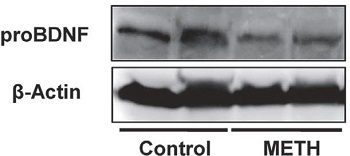Overview
- Peptide (C)DEDQKVRPNEENNKDAD, corresponding to amino acid residues 72-88 of human BDNF (precursor) (Accession P23560). Pro-domain of the BDNF protein.
- Mouse recombinant proBDNF (1:400), rat glioma C6 and human neuroblastoma SH-SY5Y cell lines (1:200).
 Western blot analysis of rat glioma C6 (1, 3) or human neuroblastoma SH-SY5Y (2, 4) cell lysate:1,2. Anti-proBDNF Antibody (#ANT-006), (1:200).
Western blot analysis of rat glioma C6 (1, 3) or human neuroblastoma SH-SY5Y (2, 4) cell lysate:1,2. Anti-proBDNF Antibody (#ANT-006), (1:200).
3,4. Anti-proBDNF Antibody, preincubated with proBDNF Blocking Peptide (#BLP-NT006). Western blot analysis using Anti-proBDNF Antibody (#ANT-006), (1:400):1. Recombinant human proBDNF protein (#B-257), (20 ng).
Western blot analysis using Anti-proBDNF Antibody (#ANT-006), (1:400):1. Recombinant human proBDNF protein (#B-257), (20 ng).
2. Recombinant human proNGF protein (#N-280), (200 ng).
3. Recombinant proNT-3 (200 ng).
4. Recombinant human BDNF protein (#B-250), (200 ng).
5. Native mouse NGF 2.5S protein (>95%) (#N-100), (200 ng).
6. Recombinant human Neurotrophin-3 (NT-3) protein (#N-260), (200 ng).
- Rat hippocampal neurons (Danelon, V. et al. (2016) Mol. Cell. Neurosci. 75, 81.).
- Mouse and rat brain sections.
Brain derived neurotrophic factor (BDNF) is a member of the neurotrophin family of growth factors that includes nerve growth factor (NGF), neurotrophin-3 (NT-3) and neurotrophin-4/5 (NT-4/5).
All neurotrophins are synthesized as preproneurotrophin precursors that are subsequently processed within the intracellular transport pathway to yield proneurotrophins that are further processed to generate the mature form. The mature form of BDNF is a non-covalent stable homodimer that can be secreted in both constitutive and regulated pathways.
Until recently, the functional role of the neurotrophin prodomains were thought to include assistance in the correct folding of the mature protein and the sorting of the neurotrophins into the constitutive or regulated secretory pathway. However, a growing body of evidence suggests that the uncleaved proneurotrophin precursors can be secreted from cells and that they may mediate different biological functions.
The functional importance of the prodomain of BDNF was recently demonstrated in a study showing that a polymorphism that replaces valine for methionine at position 66 of the prodomain, is associated with memory defects and abnormal hippocampal function in humans. Another recent study showed that the regulated extracellular cleavage of proBDNF to mature BDNF by plasmin is necessary for establishing late-phase long-term potentiation (L-LTP), a process that involves long-lasting changes in the structure and function of hippocampal synapses. Finally, proBDNF was shown to be decreased in the brains of patients suffering from Alzheimer’s disease.
Mature BDNF binds to the specific tyrosine kinase receptor TrkB and to p75NTR, a member of the TNF receptor superfamily. proBDNF can similarly bind both receptors although it appears to have a greater affinity for the p75NTR receptor.
Application key:
Species reactivity key:

Expression of proBDNF in mouse prefrontal brain cortex.Western blot analysis of mouse prefrontal brain cortex lysates using Anti-proBDNF Antibody (#ANT-006). proBDNF expression shown in control mice and mice treated with metamphetamine (METH).Adapted from Ren, Q. et al. (2015) Transl. Psychiatry 5, e666. with permission of SPRINGER NATURE.
